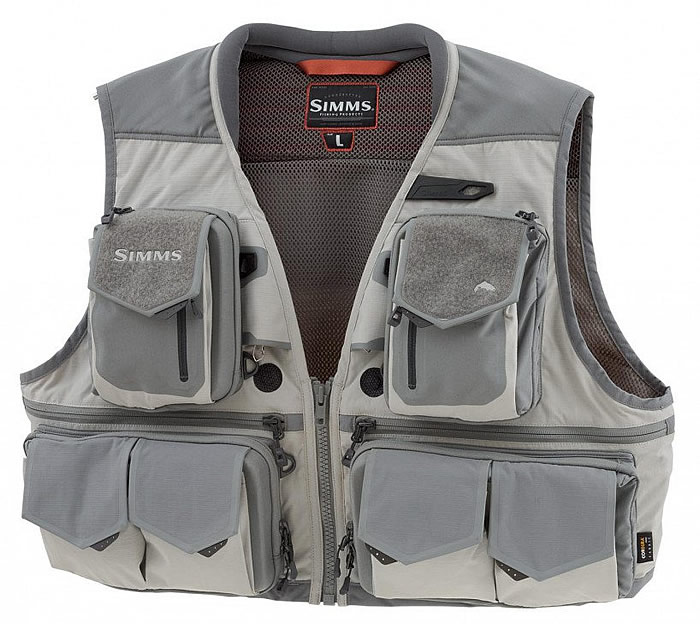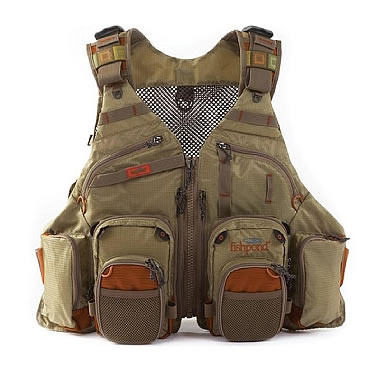A fly fishing vest is a rather boring, yet undoubtedly crucial, piece of equipment that many anglers—especially beginners—tend to overlook. Instead, beginners will load up on the fancy fly rod, titanium case and high-class sunglasses, forgetting about this piece of clothing.
 |
| The Simms Guide Vest is one of the best vests available. Durable, lightweight and functional. |
Generally, what often happens is that new anglers frequently find the cheapest fly fishing vest they can find to save money following the purchase of a pricey fly rod. Unfortunately, usually soon after purchasing these vests, the angler discovers why they were so cheap. Generally, most really cheap fishing vests break down quickly, unravel by the threads, are not terribly comfortable and have a pocket system designed by someone who doesn't know what a fly rod is.
So, to help anglers, I've put together a buyers guide about fly fishing vests. True, purchasing a vest that doesn't work too well won't ruin a trip to Montana or elsewhere. However, having a miserable excuse of a fishing vest makes life on the river unorganized, cluttered and uncomfortable—all things that take away from a productive and enjoyable day of fly fishing.
This guide covers the following topics:
Pockets, Pockets & More Pockets
To begin, let’s start with what a fly fishing vest actually does. Basically, a fly fishing vest is what holds all those myriad of streamside fly fishing things. Those things the fly fishing vest holds range from clippers, flies, leaders, tippets, various tools, line cleaners, fly floatants, weights and frequently a bewildering array of other little things.
Since a fly fishing vest is nothing more than a piece of clothing designed to hold all the little stuff inherent in the sport of fly fishing, it's not particularly surprising that a good fly fishing vest should have quite a few pockets to hold it all.
Now, that said, while you should have a good supply of pockets on any vest you get, there is such a thing as having too many of them. After all, having a vest with fifty pockets will do little good since anything needed will soon be lost among the jumble of pockets. The result is that instead of spending time casting towards a rising trout after quickly attaching an accessible fly, you'll end up on a fruitless search through your own vest for the fly you know you have but can't for the world find.
 |
| A high-quality vest from Fish Pond. Lots of pockets...but not too many. See more FishPond vests at FishWest. |
Another drawback of having too many pockets on a fly fishing vest is that you will soon find stuff to put in them. What's bad about that, you ask? Well, as any backpacker can tell you, the more space you have in your pack, the more you bring—even if it isn’t needed. As such, a fly fishing vest that a multitude of pockets will quickly weigh a ton, creating fatigue, discomfort and is destined to become an organizational nightmare.
Remember, you don't have to pack away the kitchen sink in your vest. There is nothing illegal about heading into the water with just the bare necessities, leaving the rest in your car or truck should the event arise that you need it. Having just the bare necessities in the vest helps keep everything organized and lightweight.
So, how many pockets should you get on a fly fishing vest? Well, while it's open to debate, I suggest somewhere between 10-20 pockets, give or take a few. This number of pockets will be plenty—probably more than plenty—to hold everything needed without going overboard and creating hopeless disorganization in the vest.
Size of Pockets
The next thing that needs to be taken into account on the fly fishing vest is not only the number of pockets, but the size of them, too. Having a bunch of pockets does little good if the pockets are too small to hold essential items. Conversely, having a dazzling array of little pockets creates endless frustration while attempting to find something but memory has failed on where it was last put.
Personally, I'm not a fan of fly fishing vests that have a ton of little pockets on them. I've found that 6-8 relatively small pockets is just enough to hold the little things while out on the stream, including things like your wallet and car keys. For the medium sized to larger pockets, I've found 4-6 of them is generally enough to hold all the fly boxes, leaders and other things needed, at least if the car is within easy walking distance. Obviously, if you'll be miles away from your vehicle and will be facing uncertain fishing conditions, a more spacious fishing vest may be needed.
Mesh Vest or Traditional Vest?
The next thing that needs to be decided is whether to get a mesh fly fishing vest or a standard fabric one. A mesh vest is basically a stretch mesh with fabric sewed on where the pockets go. The nice thing about mesh fly fishing vests is that, since they are mesh, on hot days the angler will stay a bit cooler. I've also found that mesh fly fishing vests tend to stretch a bit more with the movements of the angler, but that might just be me. Really, in the end, whether to get a mesh fly fishing vest or just a standard fabric one (get a good fabric one, though) is more a personal preference than anything.
Comfort is Everything
Finally, let's move onto the comfort of the vest. Fishing all day in an uncomfortable fly fishing vest is a recipe for misery, akin to carrying around an ugly and spasmodic monkey for a few hours. As such, it is highly recommended that any fishing vest purchased have a system to reduce the weight of the vest on the neck and shoulders. Many new fishing vests help distribute the weight of the vest around the entire upper body and help prevent uncomfortable stress points from developing.
Hopefully, this short article about what to look for when shopping around for a vest will help new anglers get the right vest the first time, thus avoiding the need to get another one a year later. Remember, a fly fishing vest is worn, and as such, comfort is very important. Additionally, fly fishing vests take quite a bit of abuse—once off the stream they are frequently hung up wet and forgotten about, usually for long periods of time. Thus, if you are looking for a vest, spend the small extra money now for a good one. You will save money and aggravation in the long run.
Where to Buy Quality Fly Fishing Vests
There are many good fly fishing vests on the market. Unfortunately, there's also many not-so-good vests sold, too. By and large, vests made by Orvis, Cabela's, Simm's and Redington are all high-quality and should last many years provided they are properly cared for (don't stuff a wet vest in a plastic bag and forget about it).
I personally have a Orvis Clearwater Mesh Vest and have no complaints about it. The vest has proven durable, very comfortable and functional.
Fly fishing vests are widely available online and off. Online, Cabela's, Patagonia and Simms all sell quality vests.
Offline, any good fly shop should carry a multitude of quality vests as well. Just be sure to avoid the "Wal-Mart Specials." These types of vests have a nasty tendency to fall apart quickly, especially after getting wet a few times.
- Simms Fishing Vests - Manufacturers top quality and very popular vests that last a lifetime with proper care. Simms is based in Montana.
- Fly Fishing Vests at Fishwest - Fishwest has a great selection of quality fishing vestsfrom Simms, FishPond and others.
- Fly Fishing Vests at Cabela's - Carries the largest selection of vests, including those made by Simm's, Cabela's own brand and Redington.
- Patagonia Fly Fishing Vests - Patagonia makes just a couple of vests, but the ones they have are very nice and extremely durable.
- The Rivers Edge - A respected fly shop in Bozeman that sells vests from Simms and other brands.
